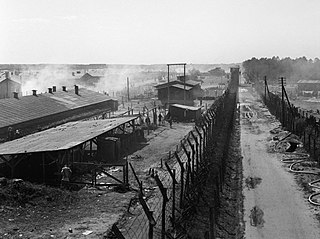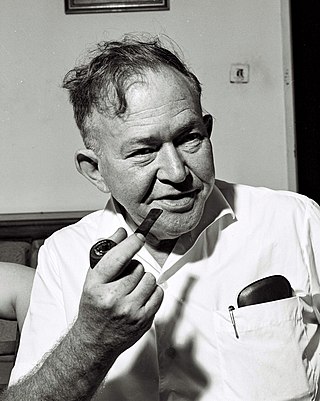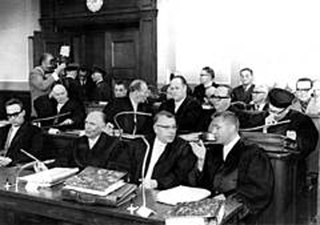
Aharon Hoter-Yishai (January 1, 1905 - May 20, 2003) was the Israeli Military Advocate General in 1948-1950 and testified at the Eichmann trial in 1961.

Aharon Hoter-Yishai (January 1, 1905 - May 20, 2003) was the Israeli Military Advocate General in 1948-1950 and testified at the Eichmann trial in 1961.
In 1945 Hoter-Yishai was an officer of the Jewish Brigade in the Second World War. He served in Italy, Yugoslavia and Austria.
Hoter-Yishai was at the forefront of absolving Meir Tobianski posthumously. Tobianski had been put on trial in June 1948 and executed for being a traitor. Hoter-Yishai presided over a retrial at which he was found not guilty. He was tasked with coordinating the activities of the Brigade by Yehudah Arazi of the Aliyah B Organization. [1] He visited several of the Nazi camps and places where Jewish survivors were including Freimann Flak-Kaserne and the St. Ottilien Archabbey. In June 1945 he arrived at Theresienstadt. He also visited the camps at Dachau, Bergen-Belsen, and Mauthausen. [2]
In 1961 Hoter-Yishai was called as witness in the trial of Adolf Eichmann. He testified regarding what he found at the concentration camps his brigade liberated:
Attorney General: "Mr. Hoter-Yishai, in 1945, at the end of the Second World War, you were in Europe as an officer in the second battalion of the Jewish Brigade – is that correct?"
Witness Hoter-Yishai: "Correct...I believe that if I were to try to confine myself to a few sentences, I could say: We found a collection of living people who, psychologically, were not very different from those corpses we found lying there without limbs and even heads. From the physical point of view, everything was done, to a certain extent, especially during the first stages, in order to put them back on their feet, as far as that was possible. If my memory serves me correctly, there were, at the time, in Bergen-Belsen, 52,000 refugees, of whom 27,000 died in the course of receiving medical treatment." [1]

Bergen-Belsen, or Belsen, was a Nazi concentration camp in what is today Lower Saxony in northern Germany, southwest of the town of Bergen near Celle. Originally established as a prisoner of war camp, in 1943, parts of it became a concentration camp. Initially this was an "exchange camp", where Jewish hostages were held with the intention of exchanging them for German prisoners of war held overseas. The camp was later expanded to hold Jews from other concentration camps.

Irmgard Ilse Ida Grese was a Nazi concentration camp guard at Ravensbrück and Auschwitz, and served as warden of the women's section of Bergen-Belsen. She was a volunteer member of the SS.

The Belsen trials were a series of several trials that the Allied occupation forces conducted against former officials and functionaries of Nazi Germany after the end of World War II. British Army and civilian personnel ran the trials and staffed the prosecution and judges.

The Holocaust—the murder of about six million Jews by Nazi Germany from 1941 to 1945—is the most-documented genocide in history. Although there is no single document which lists the names of all Jewish victims of Nazi persecution, there is conclusive evidence that about six million Jews were murdered. There is also conclusive evidence that Jews were gassed at Auschwitz-Birkenau, the Operation Reinhard extermination camps, and in gas vans, and that there was a systematic plan by the Nazi leadership to murder them.

Josef Kramer was a Hauptsturmführer and the Commandant of Auschwitz-Birkenau and of the Bergen-Belsen concentration camp. Dubbed The Beast of Belsen by camp inmates, he was a German Nazi war criminal, directly responsible for the deaths of thousands of people. He was detained by the British Army after the Second World War, convicted of war crimes, and hanged on the gallows in the prison at Hamelin by British executioner Albert Pierrepoint.

The Kastner train is the name usually given to a rescue operation which saved the lives of over 1,600 Jews from Hungary during World War 2. It consisted of 35 cattle wagons that left Budapest on 30 June 1944, during the German occupation of Hungary, ultimately arriving safely in Switzerland after a large ransom was paid to the Nazis. The train was named after Rudolf Kastner, a Hungarian-Jewish lawyer and journalist, who was a founding member of the Budapest Aid and Rescue Committee, a group that smuggled Jews out of occupied Europe during the Holocaust. Kastner negotiated with Adolf Eichmann, the German SS officer in charge of deporting Hungary's Jews to Auschwitz in German-occupied Poland, to allow over 1,600 Jews to escape in exchange for gold, diamonds, and cash. The deal was controversial and has been the subject of much debate and criticism, with some accusing Kastner of collaborating with the Nazis, while others argue that he made difficult choices to save lives.

Bergen-Belsen displaced persons camp was a displaced persons (DP) camp for refugees after World War II, in Lower Saxony in northwestern Germany, southwest of the town of Bergen near Celle. It was in operation from the summer of 1945 until September 1950. For a time, Belsen DP camp was the largest Jewish DP camp in Germany and the only one in the British occupation zone with an exclusively Jewish population. The camp was under British authority and overseen by the United Nations Relief and Rehabilitation Administration (UNRRA) with camp directors that included Simon Bloomberg. Today, the camp is a Bundeswehr barracks, having been a British Army base until 2015.

Siegfried Seidl was an Austrian career officer and World War II commandant of the Theresienstadt concentration camp located in the present-day Czech Republic. He was also the commandant of the Bergen-Belsen, and later served as a staff officer to Adolf Eichmann. After the war, Seidl was tried in Austria and convicted as a war criminal, sentenced to death, and executed by hanging.

Fritz Klein was a Romanian-German Nazi doctor and war criminal, hanged for his role in atrocities at Auschwitz concentration camp and Bergen-Belsen concentration camp during the Holocaust.

Joel Brand was a member of the Budapest Aid and Rescue Committee, an underground Zionist group in Budapest, Hungary, that smuggled Jews out of German-occupied Europe to the relative safety of Hungary, during the Holocaust. When Germany invaded Hungary in March 1944, Brand became known for his efforts to save the Jewish community from deportation to the Auschwitz concentration camp in occupied Poland and the gas chambers there.

Anita Lasker-Wallfisch is a German-British cellist, and a surviving member of the Women's Orchestra of Auschwitz.

Abel Jacob Herzberg was a Dutch Jewish lawyer and writer, whose parents were Russian Jews who had come to the Netherlands from Lithuania. Herzberg was trained as a lawyer and began a legal practice in Amsterdam, and became known as a legal scholar also. He was a Zionist from an early age, and around the time of the outbreak of World War II he attempted to emigrate with his family to Palestine. During the war he remained active in Jewish organizations until he was interned, with his wife, in Bergen-Belsen concentration camp, where his legal background and status as a legal scholar earned him a seat on a prisoners' court. After their captors moved them from Bergen-Belsen, he and his wife were later liberated by the Soviets and made it back to the Netherlands, where they were reunited also with their children. He continued his legal practice in Amsterdam, though he traveled to Palestine and was offered an administrative position in newly-founded Israel.

Franz Hößler, also Franz Hössler was a Nazi German SS-Obersturmführer and Schutzhaftlagerführer at the Auschwitz-Birkenau, Dora-Mittelbau and Bergen-Belsen concentration camps during World War II. Captured by the Allies at the end of the war, Hößler was charged with war crimes in the First Bergen-Belsen Trial, found guilty, and sentenced to death. He was executed by hanging at Hameln Prison in 1945.

The Eichmann trial was the 1961 trial in Israel of major Holocaust perpetrator Adolf Eichmann who was captured in Argentina by Israeli agents and brought to Israel to stand trial. The capturing of Eichmann was criticized by the United Nations, calling it a "violation of the sovereignty of a Member State". His trial, which opened on 11 April 1961, was televised and broadcast internationally, intended to educate about the crimes committed against Jews by Nazi Germany, which had been secondary to the Nuremberg trials which addressed other war crimes of the Nazi regime. Prosecutor and Attorney General Gideon Hausner also tried to challenge the portrayal of Jewish functionaries that had emerged in the earlier trials, showing them at worst as victims forced to carry out Nazi decrees while minimizing the "gray zone" of morally questionable behavior. Hausner later wrote that available archival documents "would have sufficed to get Eichmann sentenced ten times over"; nevertheless, he summoned more than 100 witnesses, most of whom had never met the defendant, for didactic purposes. Defense attorney Robert Servatius refused the offers of twelve survivors who agreed to testify for the defense, exposing what they considered immoral behavior by other Jews. Political philosopher Hannah Arendt reported on the trial in her book Eichmann in Jerusalem: A Report on the Banality of Evil. The book had enormous impact in popular culture, but its ideas have become increasingly controversial.

The two Treblinka trials concerning the Treblinka extermination camp personnel began in 1964. Held at Düsseldorf in West Germany, they were the two judicial trials in a series of similar war crime trials held during the early 1960s, such as the Jerusalem Adolf Eichmann trial (1961) and the Frankfurt Auschwitz Trials (1963–65), as a result of which the general public came to realize the extent of the crimes that some two decades earlier had been perpetrated in occupied Poland by German bureaucrats and their willing executioners. In the subsequent years, separate trials dealt with personnel of the Bełżec (1963–65), Sobibor (1966), and Majdanek (1975–81) extermination camps.

Dov Freiberg born Berek Freiberg, was a Holocaust survivor, writer, and witness at the Eichmann trial and the Demjanjuk case. Freiberg was a prisoner at Sobibor extermination camp where he participated in the Sobibor prisoners' revolt. After the revolt, he managed to escape into nearby woods and survived until the Soviet Army entered in July 1944.

The Sobibor trial was a 1965–66 judicial trial in the West German prosecution of SS officers who had worked at Sobibor extermination camp; it was held in Hagen. It was one of a series of similar war crime trials held during the early and mid-1960s, such as the 1961 trial of Adolf Eichmann by Israel in Jerusalem, and the Frankfurt Auschwitz Trials of 1963–65, also held in West Germany. These trials heightened general public and international understanding of the extent of the crimes that had been perpetrated in occupied Poland some twenty years earlier by Nazi bureaucrats and persons acting as their executioners.

Kalman Taigman also Teigman Hebrew: קלמן טייגמן was an Israeli citizen who was born and grew up in Warsaw, Poland. One of the former members of the Jewish Sonderkommando who escaped from the Treblinka extermination camp during the prisoner uprising of August 1943, Taigman later testified at the 1961 Eichmann Trial held in Jerusalem.
Denise Holstein is an Auschwitz concentration camp survivor and Holocaust witness, who was liberated on 15 April 1945. As a Holocaust witness, Holstein tells her story in two books and in a documentary made by a student from the Lycée Corneille in Rouen. For almost fifty years, Holstein never spoke about her life before writing about it. As a Holocaust witness, Holstein visits school children, to describe and share her experiences.

Kurt Schlesinger was a German Jewish administrative director of Westerbork transit camp during World War II.